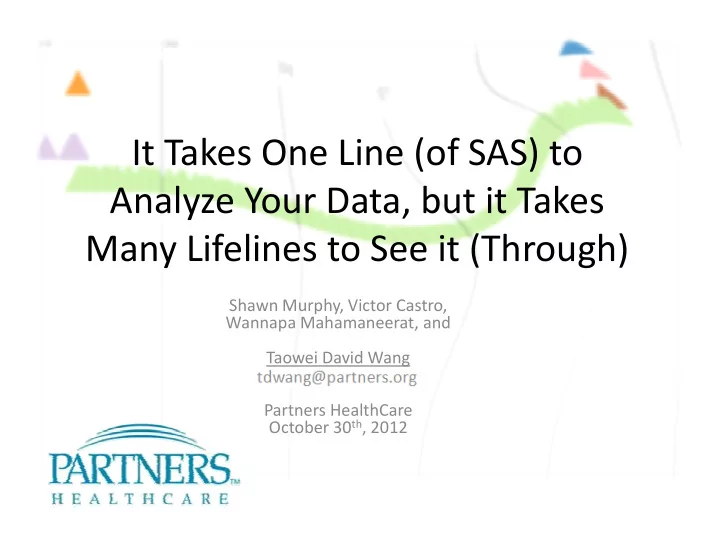

It Takes One Line (of SAS) to Analyze Your Data, but it Takes Many Lifelines to See it (Through) Shawn Murphy, Victor Castro, Wannapa Mahamaneerat, and Taowei David Wang Partners HealthCare October 30 th , 2012
Does Glargine Increase Cancer Risk? • A large German study on diabetes database suggests so – Controversial, but very large sample – Other Countries did the same study – Other Countries did the same study • Sweden, UK, Scotland – Conflicting results • What about our own data? – Focus on glargine and pancreatic cancer – Performed 2 studies
Cohort Study from EHR 70,772 Patients 1980-2010 All Patients with some with some form of Insulin Therapy
Cohort Study from EHR 70,772 Patients Glargine 2135 Glargine only 51177 Other insulin only All 17460 Both Insulin Patients Other Insu with some with some form of Insulin Therapy Both
Cohort Study from EHR Glargine All Insulin Patients Other Insu with some with some Statistical Significance Statistical Significance form of Insulin Therapy Both
Cohort Study from EHR Glargine All Insulin Patients Other Insu with some with some Statistical Significance Statistical Significance form of But in Lifelines2, we see that Insulin Therapy Order of Cancer and Glargine is not enforced. Both cancer glargine
Cohort Study from EHR Glargine All Insulin Patients Other Insu with some with some Statistical Significance Statistical Significance form of But in Lifelines2, we see that Insulin Therapy Order of Cancer and Glargine is not enforced. Both cancer glargine Nor is the time taken from Glargine to Cancer taken into account.
Cohort Study from EHR Glargine All Patients with Pancreatic Other Insulin All Cancer Patients after with some with some Exposure Exposure form of to Insulin Both Insulin Therapy Therapy
Cohort Study from EHR Glargine All Patients with Pancreatic Other Insulin Much smaller All Cancer Statistical Significance! Patients after with some with some Exposure Exposure form of to Insulin Both Insulin Therapy Therapy
Case-Control Study in EHR All 8000+ pancreatic cancer patients (cases) Patients with Pancreatic Cancer
Case-Control Study in EHR All 8000+ pancreatic cancer patients (cases) Patients with Pancreatic Cancer 25000+ pancreatic cancer patients (controls) Matched by Matched Age Controls: Gender Patients Fact Counts without Start and End Dates Pancreatic Cancer
Case-Control Study in EHR All 8000+ pancreatic cancer patients (cases) Patients with Pancreatic Cancer Fact Counts But… Fact distribution can be very different Matched Controls: Patients without Pancreatic Cancer
Case-Control Study in EHR All 8000+ pancreatic cancer patients (cases) Patients with Pancreatic Cancer Fact Counts But… Fact distribution can be very different Matched Controls: Patients Case without Pancreatic spike Cancer Control
Case-Control Study in EHR All 8000+ pancreatic cancer patients (cases) Patients with Pancreatic Cancer Fact Counts But… Fact distribution can be very different Matched Controls: We used Fact Count/Year. Patients without Pancreatic No Statistical Significance Cancer
Summary • Running statistical analysis is easy • Ensuring our data is – Clean, representative, and suitable for the type of analysis is not analysis is not • Lifelines2 is helpful – Check if our data is clean – See if matching criteria are appropriate – Present patient data to colleagues
References and Links • Lifelines2 in i2b2 (TimeAlign) https://community.i2b2.org/wiki/display/timealign/TimeAlign • Hemkens, L., et al., Risk of malignancies in patients with diabetes treated with human insulin or insulin analogues: a cohort study. Diabetologia, 2009. 52(9): p. 1732-1744. http://dx.doi.org/10.1007/s00125-009-1418-4 • Colhoun, H., Use of insulin glargine and cancer incidence in Scotland: a study from the Scottish Diabetes Research Network Epidemiology Group. Diabetologia, 2009. 52(9): p. 1755-1765. http://dx.doi.org/10.1007/s00125-009-1453-1 • Currie, C., C. Poole, and E. Gale, The influence of glucose-lowering therapies on cancer risk in type 2 diabetes. Diabetologia, 2009. 52(9): p. 1766-1777. http://dx.doi.org/10.1007/s00125-009-1440-6 • Jonasson, J., et al., Insulin glargine use and short-term incidence of malignancies—a population-based follow-up study in Sweden. Diabetologia, 2009. 52(9): p. 1745-1754. http://dx.doi.org/10.1007/s00125-009-1444-2 Sweden. Diabetologia, 2009. 52(9): p. 1745-1754. http://dx.doi.org/10.1007/s00125-009-1444-2 • Rosenstock, J., et al., Similar risk of malignancy with insulin glargine and neutral protamine Hagedorn (NPH) insulin in patients with type 2 diabetes: findings from a 5 year randomised, open-label study. Diabetologia, 2009. 52(9): p. 1971-1973. http://dx.doi.org/10.1007/s00125-009-1452-2 (letter to the editor) Smith, U. and E. Gale, Does diabetes therapy influence the risk of cancer? Diabetologia, 2009. 52(9): p. 1699-1708. • http://dx.doi.org/10.1007/s00125-009-1441-5 (editorial) • Pocock, S.J. and L. Smeeth, Insulin glargine and malignancy: an unwarranted alarm. The Lancet, 2009. 374(9689): p. 511-513. Gale, E.A.M., Insulin glargine and cancer: another side to the story? The Lancet, 2009. 374(9689): p. 521-521. •
Backup Slides
Cohort • Start with people with Glargine and people with other insulin and follow them longitudinally to see who develops cancer. • Relative risk. • Relative risk.
Case-Control • Focus only on patients who have pancreatic cancer (case) and select similar patients to compare with (control) • Odds-ratio • Odds-ratio • Better-suited because pancreatic cancer is a relatively rare condition. This way we narrow the scope
Relative Risk No Pancreatic Pancreatic Cancer Cancer Glargine a b No Glargine c d Relative Risk = (a/(a+b)) / (c/(c+d))
Recommend
More recommend